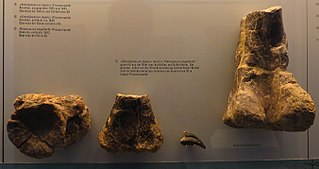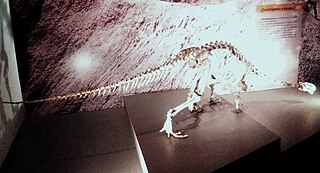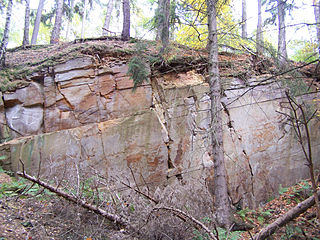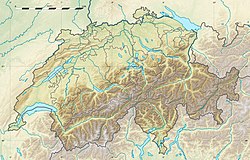
Melanorosaurus is a genus of basal sauropodomorph dinosaur that lived during the Late Triassic period. A herbivore from South Africa, it had a large body and sturdy limbs, suggesting it moved about on all fours. Its limb bones were massive and heavy like the limb bones of true sauropods.

Procompsognathus is an extinct genus of coelophysid theropod dinosaur that lived approximately 210 million years ago during the later part of the Triassic Period, in what is now Germany. Procompsognathus was a small-sized, lightly built, ground-dwelling, bipedal carnivore, that could grow up to 1 m (3.3 ft) long.

Proganochelys is an extinct, primitive stem-turtle that has been hypothesized to be the sister taxon to all other turtles creating a monophyletic group, the Casichelydia. Proganochelys was named by Georg Baur in 1887 as the oldest turtle in existence at the time. The name Proganochelys comes from the Greek word ganos meaning 'brightness', combined with prefix pro, 'before', and Greek base chelys meaning 'turtle'. Proganochelys is believed to have been around 1 meter in size and herbivorous in nature. Proganochelys was known as the most primitive stem-turtle for over a century, until the novel discovery of Odontochelys in 2008. Odontochelys and Proganochelys share unique primitive features that are not found in Casichelydia, such as teeth on the pterygoid and vomer and a plate-like coracoid.

Isanosaurus is an extinct genus of sauropod dinosaur from Thailand. It was originally dated to approximately 210 million years ago during the Late Triassic, which would make it one of the oldest known sauropods. Its age was later considered uncertain, and may be Early Jurassic or even as young as Late Jurassic. The only species is Isanosaurus attavipachi. Though important for the understanding of sauropod origin and early evolution, Isanosaurus is poorly known. Exact relationships to other early sauropods remain unresolved.

Lessemsaurus is an extinct genus of sauropod dinosaur belonging to Lessemsauridae.

Liliensternus is an extinct genus of basal neotheropod dinosaur that lived approximately 210 million years ago during the latter part of the Triassic Period in what is now Germany. Liliensternus was a moderate-sized, bipedal, ground-dwelling carnivore, that could grow up to 5.15 m (16.9 ft) long. It is the best represented Triassic theropod from Europe and one of the largest known.

Gresslyosaurus is a genus of plateosaurian sauropodomorph dinosaur that lived during the Late Triassic period, around 214 to 204 million years ago, in France, Germany and Switzerland.
Zanclodon is an extinct genus of archosauriform from the Erfurt Formation in southern Germany. It was once a wastebasket taxon until a taxonomic revision by Schoch (2011) left only the paratype within Zanclodon laevis proper. The type species is Z. laevis.

Massopoda is a clade of sauropodomorph dinosaurs which lived during the Late Triassic to Late Cretaceous epochs. It was named by paleontologist Adam M. Yates of the University of the Witwatersrand in 2007. Massopoda is a stem-based taxon, defined as all animals more closely related to Saltasaurus loricatus than to Plateosaurus engelhardti.

The Trossingen Formation, formerly the Knollenmergel, is a geological formation in Germany and Switzerland. It dates back to the late Norian-Rhaetian.

Adeopapposaurus is a genus of prosauropod dinosaur from the Early Jurassic Cañón del Colorado Formation of San Juan, Argentina. It was similar to Massospondylus. Four partial skeletons with two partial skulls are known.
The Tomanová Formation is a Late Triassic geologic formation in Poland and Slovakia. Fossil theropod tracks have been reported from the formation.
The Marnes de Châlins is a Late Triassic geologic formation in France. Dinosaur remains are among the fossils that have been recovered from the formation, although none have yet been referred to a specific genus.
The Stuttgart Formation is a geologic formation in Germany. It preserves fossils dating back to the Carnian stage of the Triassic period.

The Exter Formation is the only formation of the Upper Keuper or Rhätsandstein, and is a geologic formation in Germany. It preserves fossils dating back to the Rhaetian of the Triassic period.
Sefapanosaurus was an early, herbivorous sauropodomorph dinosaur occurring in the southern regions of Gondwana some 200 million years ago in the Late Triassic or Early Jurassic. The sauropodomorphs were the dominant terrestrial herbivores throughout much of the Mesozoic Era, from their origins in the mid-Triassic until their decline and fall at the end of the Cretaceous. A distinctive feature of this dinosaur is the cross-shaped astragalus or talus bone in its ankle. The generic name is derived from the Sesotho word sefapano, meaning ‘cross’ and the Greek word saurus, meaning 'lizard'. The specific name refers to Zastron, the type locality, where the specimen was discovered.

Notatesseraeraptor is a genus of carnivorous theropod dinosaur that lived during the Late Triassic of what is now Switzerland. It was found in the Gruhalde Member of the Klettgau Formation. It was an early member of Neotheropoda with affinities to Dilophosaurus and Averostra. The new genus and species Notatesseraeraptor frickensis was named by Marion Zahner and colleagues in 2019.
Schleitheimia, is an extinct genus of sauropodiform sauropodomorph dinosaur, from the Gruhalde Member of Klettgau Formation of Switzerland. The type species, Schleitheimia schutzi was formally described in 2020.
Bernhard Peyer was a Swiss paleontologist and anatomist who served as a professor at the University of Zurich. A major contribution was on the evolution of vertebrate teeth.
Deltadectes is an extinct genus of early rhynchocephalian from the Late Triassic Klettgau Formation of Switzerland. It contains a single species, Deltadectes elvetica.












